The feat of the Russian troops in the battle of Kraon
prehistory
After the retreat of the Main Army of Schwarzenberg, the auxiliary army of Blucher was given the task of conducting active offensive operations. Blucher’s army was reinforced by the Russian corps of Wintzingerode and Prussian by Bülow from the Northern Allied Army of Bernadotte.
On the night of February 24, Blucher’s army began to move. He headed northwest, planning to smash the divided, weak barriers of Marshals Marmont and Mortier. 27 February Allied troops approached Laferte-sous-Joir (75 km east of the French capital) on Marne. However, the French troops managed to retreat.
Napoleon originally planned to continue the pressure on the Main Army, but after learning about the dangerous movement of the army, Blucher decided to strike at a more decisive enemy. Leaving against the troops of Marshals Oudinot, MacDonald and General Gerard against Schwarzenberg, Napoleon 27 of February moved from Troy to Laferte-soo-Joir, intending to go back to the allied army.
Schwarzenberg's army continued to retreat. However, after the weakening of the pressure of the French troops was discovered, the Allied monarchs forced Schwarzenberg to stop. 27 February 1814, the Russian corps of Wittgenstein with the support of the Austro-Bavarian corps Wrede defeated the forces of Marshal Oudinot (Battle of Bar-sur-Aube). Allied forces 5 March once again occupied Troy, but here Schwarzenberg stopped the movement. As a result, Napoleon had freedom of action in the fight against Blucher.
Upon learning of the movement of Napoleon’s army, Blücher began moving northward to Soissons on Ene to connect with the corps of Wintzingerode and Bülow. The Wintzingerode Corpus moved from Reims (east of Soissons) along the left (or southern) bank of the Enes, the Bilov Prussian corps went from Laon, that is, it was located on the right bank opposite to Blucher and Wintzingerode. Soissons had the only nearest bridge over Enu. In the fortress there was a French garrison (1,5 thousand Poles). Another crossing was in the town of Berry-au-Bak, but the French had to go to her earlier than the Allied forces. The Allies, threatening to storm, persuaded the garrison of Soissons to leave the fortress. 3 march garrison with weapons and left the flags of the fortress. March 4 Blucher's army crossed over to the right bank of the Ena. She joined the corps of Wintzingerode and Bülow, doubled and began to total 100-110 thousand soldiers.
5 March Napoleon tried to beat off Soisson, but failed. He had to 6 March to force Enu higher, in the town of Berry-a-Bak. The Wintzingerode corps, due to slow concentration, did not have time to disrupt the enemy’s crossing. The French cavalry of Nansuti struck a quick blow and easily knocked over the cover of the crossing.
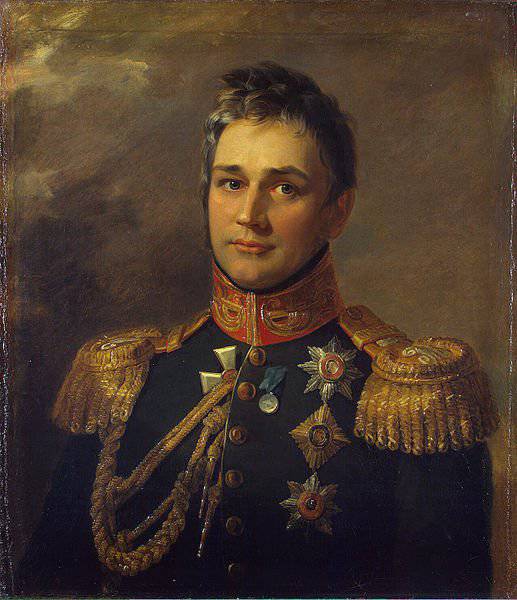
Mikhail Semenovich Vorontsov (1782 — 1856).
Party plans
According to some researchers who refer to the memoirs of Marshal Marmont, Napoleon planned to break through to the North to the Rhine and to Holland to unlock the French garrisons there. This could give him an additional army - 50 thousand soldiers. Napoleon himself had 40-50 thousand people. With such forces, the French emperor could hope to defeat the army of opponents in France.
Blucher planned, holding the defense part of the forces in the defile between Ena and Summer, to tie down the French army here, at this time part of the Allied army had to make a detour and strike at the rear of the enemy. Army Blucher took a stretched position from the banks of the river. Enes to the city of Laon. The army occupied a line of at least 45 miles. However, despite this, Blucher could gather at any dangerous point, for 5-6 hours, at least 40-50 thousand people, which exceeded the forces of the enemy.
Infantry divisions under the general command of Vorontsov (16,3 thousand infantry, about 2 thousand regular cavalry and Cossacks, 96 guns) from the Wintzingerode corps took the leading positions. The Russian infantry occupied a vantage point on the Kraon plateau between the villages of Vassogne and Isle, a mile from Ena. In the reserve was the Russian corps Osen-Saken (9 thousand people). The Kraon positions did not allow to place more troops, therefore the Saken corps was located in the area of Bree. The closest to the troops of Vorontsov was the Vasilchikov cavalry — 2,7 thousand people and the Cossack detachment of Karpov — 1,5 thousand. The Prussian Corps of Bülow (17 thousand soldiers) stood in Laon. The corps of York and Kleist (23 thousand people) were located on the plateau between Laon and Soissons. In Soissons there was a Russian detachment (6-9 thousand people) under the command of General Rudziewicz.
The combined cavalry corps (10 thousand people with 60 guns) under the command of Wintzingerode received the task of crossing the Years at Chevroni village, advancing to Festier and stabbing Berry-o-Buck on the flank or rear of the French troops when they stormed the Kraon positions. The Prussian infantry corps of Kleist was supposed to support the cavalry. The bypass maneuver of the Allied cavalry was to play a decisive role in this battle.
However, this maneuver was never carried out. Both objective and subjective factors played their role. Thus, the terrain was rugged and mountainous, which prevented the movement of cavalry. The paths were narrow and strewn with stones, often the cavalry had to go in one horse. A large number of artillery in the detachment increased the difficulties and slowed down the troops even more. Affected and errors in the choice of the route command. They increased the distance. In addition, Wintzingerode was supposed to perform on the evening of March 6, but postponed the march until the morning of March 7. As a result, the cavalry, and Kleist's infantry that came out later, simply did not have time to fight. Already during the battle, when it became clear that the cavalry did not have time, they turned it back.
On the eve of the battle of Kraon. Engraving.
Battle
Vorontsov, in order to slow down the movement of the enemy, detached avant-garde forces. The 13 th and 14 th Chasseurs regiments under the command of Major General Krasovsky, the cavalry of Palen, were sent to Kraon. To support them, Tula and Navaginsky infantry regiments were set up at the Gortebiz manor. March 6 advanced battalion of the Old Guard met with the Russian avant-garde. Russian huntsmen overturned the French advanced forces.
Napoleon sent one of the brigades of the Guards Division to help and sent Meunier's division to Goertebiz to cut off the Russian advanced units. However, Vorontsov managed to take the rangers to Goertebiz. The chasseur calmly retreated, attacking the enemy time after time. So, the 13 th regiment under the command of Colonel Mayevsky 10 once went into bayonet attacks. Division Meunier was able to capture Hertebiz. But in the evening the Russian troops counterattacked and again occupied the manor.
Russian divisions are located in three lines. In the first line, under the general command of Major General Vuich, there were 14 battalions: 13 and 14, jäger regiments, brigade of the 14 infantry division (Tula and Navaginsky regiments), Major General Ponset, 24 Vuich division. In the second line of the 7 battalions: 21-division of Lieutenant-General Laptev. In the third line, under the command of Lieutenant-General Strogonov, there were 9 battalions: the brigade of the 13 division of Major-General Zheltukhin, the 12 division of Major-General Khovansky. The Görtebiz manor in front of the position was occupied by the 14 th rangers regiment (at the beginning of the battle the huntsmen moved to the first line). The rangers supported two squadrons of hussars. In addition, Pavlograd Hussar and four Cossack regiments under the command of Major General Benkendorf (future famous Chief of the III Department of the Imperial Chancellery) were located on the right wing of the first line. The artillery was commanded by Major General Myakinin: 36 guns were located in front of the center of the first line, according to 12 guns on the flanks of the first line; The 6 guns were in the second line; the rest of the 30 guns were in reserve.
Battle plan for Kraon 23 February (March 7) 1814
7 March, the French again attacked the Russian troops. At 9 in the morning, one of the French divisions under the personal command of Marshal Victor launched an offensive (the Marshal at the very beginning of the battle was wounded in the leg and left the battlefield). Vorontsov ordered the Krasovsky detachment to withdraw to the main forces. The battle began with an artillery fire. Napoleon pulled Guards artillery - to 100 guns. Vorontsov's troops were dense columns, therefore, suffered significant losses.
Napoleon, considering that the enemy was weak enough, ordered the attack to begin. The corps of Ney, Victor and the dragoon division of Roussel (about 14 thousand people in total) were to hit the left Russian flank. Graf Nansuti with the Excelman division and Polish uhlans (about 2 thousand people in total) had to bypass the Russian positions from the right flank to Wassogne. At the same time, the French advanced units did not wait for the approach of other troops: the Charpentier divisions from the Victor corps, the Mortier corps, and the Laferier divisions (together with them, the number of the French army increased to 30 thousand). These compounds joined the battle later.
Ney's troops went on the attack and were met with strong gunfire and rifle fire. In addition, part of the corps of Victor (Division de Rebeval) consisted of conscripts, conscripts and had a weak combat capability. Ney's troops attacked Isle several times, but were thrown back. The deadly fire of the Russian batteries upset the enemy forces. General Vuich with the 2 and 19 jaeger regiments hit the Rebeval division and with the help of the hussars completely overthrew the enemy. Only the fire of the French Guards artillery saved the French division from total destruction. Nansuchi's cavalry was also not successful. She was attacked by Pavlograd hussars and Cossacks Benkendorf, not allowing to make a detour.
Napoleon, having supported Ney with the brigade of Roussel's cavalry division, and ordered the resumption of the offensive. Ney, despite great losses from the Russian fire, made a desperate effort and achieved some success. The French cavalry captured one cavalry artillery company. The commander of an artillery company, Colonel Parkenson was killed. However, Vuich organized a counterattack and the Russian soldiers rejected the enemy with a bayonet attack. General Gruchy was wounded and the French cavalry lost its superior. The French cavalry that had lost control became a good target for Russian artillery. Vorontsov, seeing the constant attacks of the enemy against the left flank, supported him with a brigade of Major-General Glebov, who had been pushed out of the third line (6 and 41, jaeger regiments).
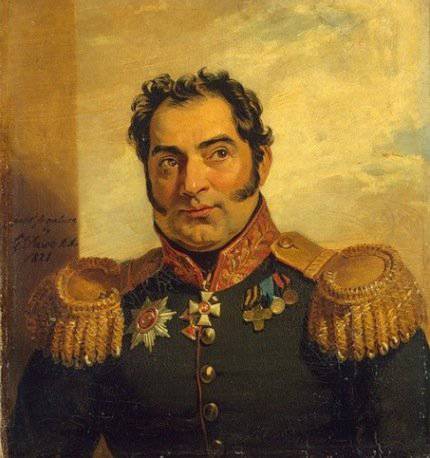
Nikolai Vasilievich Vuich (1765 — 1836).
The French infantry suffered heavy losses, their artillery fire weakened due to a significant number of wounded guns. Ney and de Rebeval sent several officers to Napoleon, asking for reinforcements. Napoleon sent Laferiere's cavalry division to the aid of de Rebeval. He also ordered the division of Charpentier and the body of Mortier to accelerate the movement.
However, even before the arrival of French reinforcements, Vorontsov ordered Major General Zvarykin, led by the Shirvan regiment and rangers, to attack the enemy. Russian soldiers overturned the French divisions. Strong Russian artillery fire intensified the frustration of the French troops. The French cavalry division of General Lafériere attempted to go into the rear of the troops of Zvarykin, but was put to flight. General LaFérier was injured.
At this time, Blucher had already abandoned the cavalry bypass movement and began to collect troops from Lana (Laon). At 2 hours, General Osten-Sacken, who was ordered to retreat to Lana, gave Vorontsov an order to withdraw troops. However, Vorontsov, successfully holding the Kraon positions for five hours, replied that further defense was more profitable than retreat if the enemy had numerous cavalry. Vorontsov had only one regiment of regular cavalry. Otsen-Saken, knowing that the cavalry could not make a detour, and Kleist’s corps was withdrawn, repeated the retreat prize. Vasilchikov's cavalry was supposed to cover the withdrawal of Vorontsov’s troops.
Vorontsov sent back all the damaged guns (22), the wounded, and then began to withdraw the troops by building them in a square. However, they had not yet managed to move from place, as the French resumed the offensive. General Charpentier led fresh forces to attack. His division was backed up by the Old Guards under Frian’s command.
The Shirvan regiment was subjected to the disastrous action of the artillery aimed at them. Lieutenant-General Vasily Danilovich Laptev gave permission to attack the enemy’s artillery positions and led the soldier himself. Shirvans threw in the attack. When Laptev was wounded, the Shirvans continued their offensive under the command of Zvarykin. However, Zvarykin was seriously wounded. As a result, during the retreat of the first line through the second, the Shirvan regiment, which attacked the enemy, was very far from its line, was surrounded by enemy cavalry. But the Shirvans did not flinch. Having shot all the bullets, the Russian warriors three times under the drumbeat made their way with bayonets. As a result, they connected with their own. At the same time, the heroes carried out their wounded commanders, all the wounded and the bodies of the dead officers.
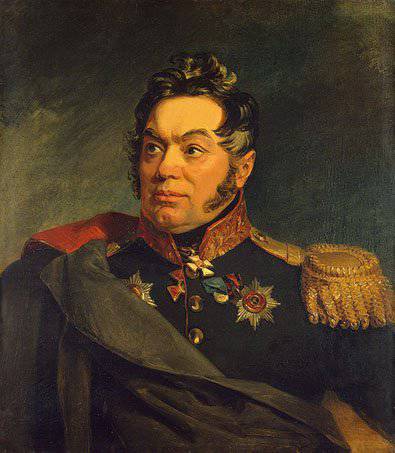
Vasily Danilovich Laptev (1758 — 1825).
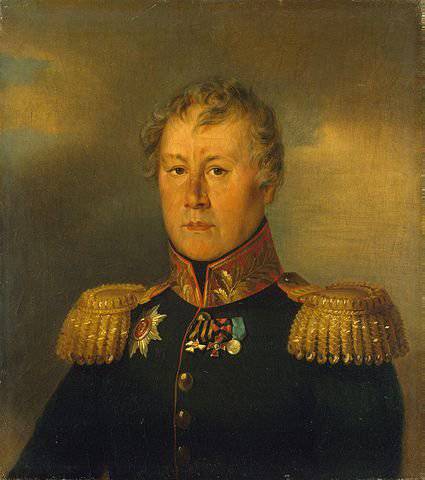
Fedor Vasilyevich Zvarykin (1765 — 1826).
Napoleon tried to upset the Russian troops and destroy them. He ordered General Drouot to enter into battle six reserve guards batteries. At the same time, he entrusted all the cavalry to Beliere and sent him to the Russian right flank, to help Nansuti.
The Russian troops retreated, as noted by Vorontsov, “as in an exercise,” in perfect order. However, the situation was dangerous. Particularly dangerous was the detachment of Benckendorf, who covered the right flank. Several times he repelled the attacks of strong enemy cavalry. Reaching Serni, Vorontsov stopped the troops behind the ravines to wait for Vasilchikov's cavalry. For the village, the terrain was more open, which allowed the French cavalry to bypass the Russian infantry.
Russian hussars and dragoons under the command of Vasilchikov, Ushakov and Lansky rejected Napoleon's cavalrymen. Some regiments went on the attack eight times. As the French themselves admitted: "the courageous and skillful attacks of the Russian cavalry stopped the swiftness of the French squadrons." In this battle, Lieutenant General Sergei Nikolayevich Lanskoy was mortally wounded. Major-General Sergei Nikolaevich Ushakov 2 died.
The advance of the French cavalry was held back by the successful actions of the rangers. The 6 th jäger regiment occupied a farm enclosed with a stone wall. Rangers let the enemy cavalry almost close and suddenly opened fire. The resilient defense of this improvised fortress caused the enemy to ease the pressure.
At this time, Osten-Sacken ordered Major General Nikitin to install Russian batteries (36 guns) on the plateau slopes. They were put in positions behind the retreating troops. They missed the troops of Vorontsov and opened fire. The French, hitting a fire bag, suffered significant losses. By 5 hours of the evening the battle was over. After a brief rest, the Russian troops retreated to Chevrinha, and then Laon.
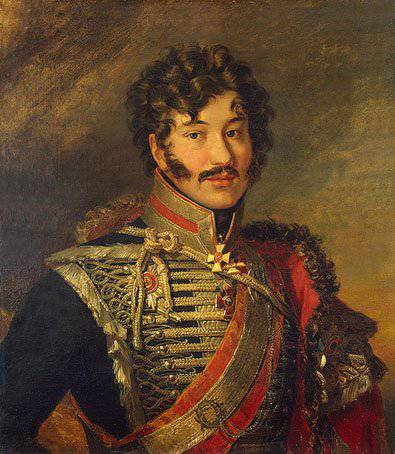
Sergey Nikolaevich Lanskoy (1774 — 1814).
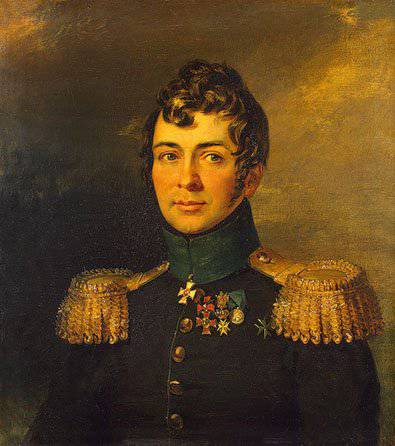
Sergey Nikolaevich Ushakov 2 (1776 — 1814).
Results
The Russian troops at the Battle of Kraon committed one of their most famous feats. Unfortunately, the battles of the 1814 campaign of the year (like the battles of the 1813 campaign of the year) are almost unknown to the general public in modern Russia. 15 Thousands of Russian soldiers withstood the blow of the double forces of the enemy under the personal leadership of Napoleon. Moreover, the Russian soldiers repulsed all the attacks of the enemy and won a number of victories in separate directions. Only an order from the high command forced the troops of Vorontsov to abandon their positions.
Russian soldiers and generals showed great courage and combat skills in this battle. General Vorontsov did everything in his power to restrain the blow of the enemy. Despite the brutal pain in the damaged leg the day before, he was always with the soldiers. He took command over one and then another regiment. Meeting the enemy at a distance of up to fifty steps with battalion fire. Count Mikhail Vorontsov received the Order of St. George for the battle 2 degree. The 4 Russian regiment was marked for valor by St. George banners.
General Lanskoy was mortally wounded in battle, Laptev and Zvarykin were wounded. Prince Khovansky, Maslov and Glebov were wounded. Major General Ushakov, Chief of the Courland Dragoon Regiment, was killed. Killed by Colonel Parkenson. The only son of Count Strogonov was struck by the nucleus.
The French also showed themselves to be the bravest fighters. It was one of the bloodiest battles of the 1814 campaign of the year, if we estimate the specific number of dead and wounded (percentage of the number of participants in the battle). So. The Shirvan regiment lost half its composition. Russian troops lost up to 5 thousand people (1,5 thousand people died, more than 3 thousand people were injured). During the retreat, the enemy was not left a single weapon. The French were able to capture only about 100 wounded.
The French lost 8 thousand people during the storming of the Kraon positions. Victor, Gruchy, LaFerrier, de Rebeval and other commanders were injured. About the rage of the battle says the fact that the division of de Rebevala lost more than two-thirds of its composition.
The seizure of the Kraon positions did not give anything to Napoleon. Blucher pulled all the cash. The feat of the Russian divisions inspired the rest of the troops. 9 — 10 March The 1814 was held at Laon, where the French were defeated.
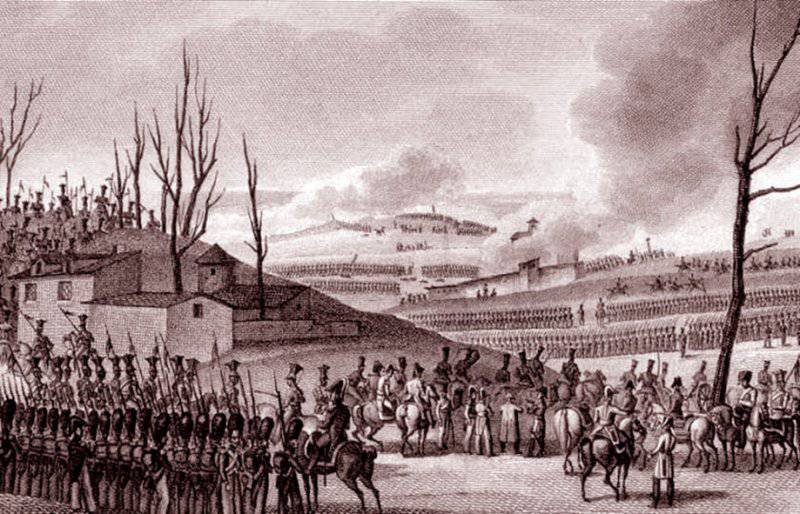
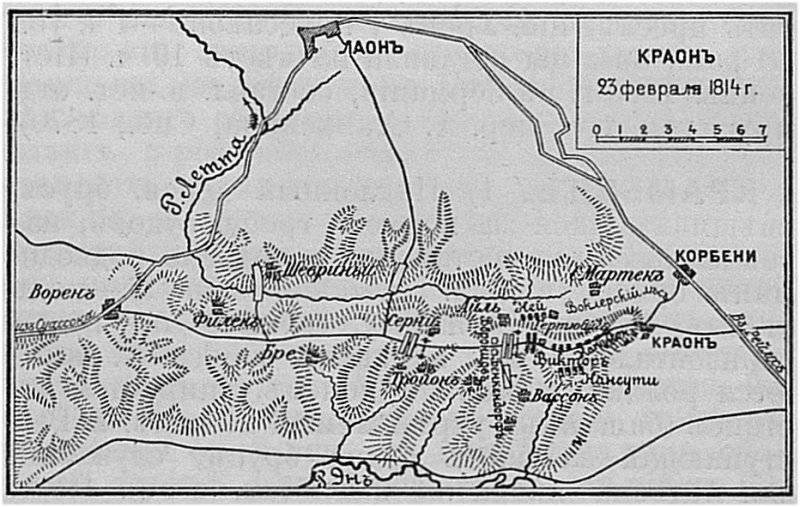
Information